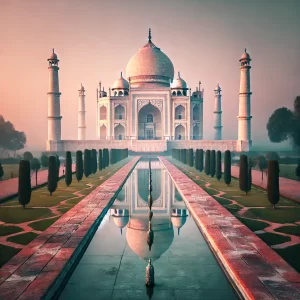India is a land where history breathes through grand palaces, majestic forts, and intricate temples. From Mughal masterpieces to ancient Hindu and Buddhist architecture, each monument tells a unique story of India’s rich past. This guide will take you through some of the most iconic and lesser-known historical monuments, offering tips on the best time to visit, entry details, and a complete itinerary to explore these timeless wonders.
Top Must-Visit Historical Monuments in India
1. Taj Mahal, Agra
A UNESCO World Heritage Site, the Taj Mahal stands as a symbol of eternal love, built by Emperor Shah Jahan for his beloved wife Mumtaz Mahal. The white marble structure is stunning at sunrise and sunset, reflecting different hues with the changing light.
- Best Time to Visit: October to March
- Entry Fee: ?50 for Indians, ?1100 for foreigners
- Travel Tip: Visit early morning to avoid the crowds.
2. Red Fort, Delhi
Once the seat of Mughal power, this massive red sandstone fort is known for its impressive architecture and historical significance. The fort remains a proud symbol of India’s fight for independence.
- Best Time to Visit: October to March
- Entry Fee: ?35 for Indians, ?500 for foreigners
- Travel Tip: Don’t miss the evening sound and light show.
3. Amber Fort, Jaipur
Perched on a hilltop, Amber Fort showcases a blend of Rajput and Mughal styles with beautiful courtyards, palaces, and a mesmerizing mirror room. The fort offers panoramic views of Maota Lake below.
- Best Time to Visit: October to March
- Entry Fee: ?100 for Indians, ?550 for foreigners
- Travel Tip: Take an elephant ride or jeep to the top for a royal experience.
4. Qutub Minar, Delhi
Standing at 73 meters, Qutub Minar is the tallest brick minaret in the world. Built in 1199 by Qutub-ud-din Aibak, the monument is surrounded by other fascinating ruins from Delhi’s earliest Islamic dynasty.
- Best Time to Visit: October to March
- Entry Fee: ?30 for Indians, ?500 for foreigners
- Travel Tip: Visit during golden hour for breathtaking photos.
5. Hampi, Karnataka
A sprawling UNESCO World Heritage Site, Hampi was once the capital of the Vijayanagar Empire. It’s dotted with captivating ruins, ancient temples, and boulder-strewn landscapes, offering a unique journey back in time.
- Best Time to Visit: October to February
- Entry Fee: Free (some sites may have small fees)
- Travel Tip: Rent a bicycle or scooter to explore at your own pace.
Hidden Historical Gems Worth Exploring
1. Chittorgarh Fort, Rajasthan
The largest fort in India, Chittorgarh stands as a testament to Rajput valor and sacrifice, with legends of Rani Padmini echoing through its grand structures.
2. Sun Temple, Konark, Odisha
Built in the 13th century, this temple resembles a massive chariot dedicated to the Sun God. The intricate stone carvings depict scenes from everyday life and mythology.
3. Sanchi Stupa, Madhya Pradesh
Commissioned by Emperor Ashoka, this Buddhist monument from the 3rd century BCE is a symbol of peace and devotion, featuring beautifully carved gateways.
Best Time to Visit Historical Monuments in India
- Winter (October to March): Ideal for sightseeing, especially in Rajasthan, Delhi, and Agra.
- Monsoon (July to September): Lush landscapes, but rain may interrupt outdoor exploration.
- Summer (April to June): Best for hill fort regions like Kumbhalgarh.
7-Day Itinerary for Exploring India’s Historical Monuments
Day 1: Delhi
- Explore Red Fort, Qutub Minar, Humayun’s Tomb, and India Gate.
- Evening: Watch the sound and light show at Red Fort.
Day 2: Agra
- Sunrise visit to Taj Mahal.
- Afternoon: Visit Agra Fort and Mehtab Bagh for a riverside view of the Taj.
- Evening: Stroll through local markets.
Day 3: Jaipur
- Visit Amber Fort, City Palace, Hawa Mahal, and Jantar Mantar.
- Evening: Dine at a rooftop restaurant overlooking the fort.
Day 4: Rajasthan Forts
- Head to Chittorgarh Fort and Kumbhalgarh Fort.
Day 5: Hampi, Karnataka
- Explore the ruins of Virupaksha Temple, Vittala Temple, and Elephant Stables.
Day 6: Konark, Odisha
- Visit the Sun Temple and unwind on nearby beaches.
Day 7: Sanchi, Madhya Pradesh
- Explore the Sanchi Stupa and nearby Udayagiri Caves.
Travel Tips for Exploring Historical Monuments
-
Entry Fees & Timings: Many monuments offer discounted rates for students and early bird visitors.
-
Guides vs. Audio Tours: Some places, like the Taj Mahal, offer government-approved guides or smartphone audio tours.
-
Local Etiquette: Respect religious customs — cover your head in temples and remove shoes when required.
-
Best Photo Spots: Share hidden corners or the best sunrise/sunset times for iconic shots.
- Dress comfortably while respecting cultural norms.
- Hire a local guide for deeper insights into the history.
- Visit early to avoid crowds and harsh sunlight.
- Stay hydrated and carry snacks.
- Check timings beforehand to plan efficiently.
Conclusion: Walk Through India’s Glorious Past
From Mughal splendor to Rajput valor and ancient spiritual sites, India’s historical monuments offer a gateway into the country’s diverse past. Whether you’re drawn to the awe-inspiring beauty of the Taj Mahal or the quiet charm of Sanchi Stupa, this guide ensures you won’t miss a thing on your historical adventure.
Ready to pack your bags and step into history?


